Sports and Entertainment
What do these photos tell you about what miners did for entertainment?
Silver Plume Baseball Team
This is a photo of the Silver Plume baseball team. Silver Plume was a mining town near Georgetown.
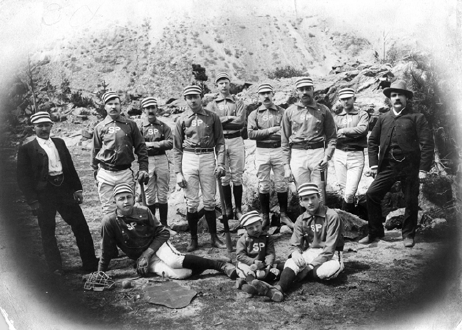
Photo: Denver Public Library, Western History Collection
More About This Topic
Many of the mining towns in Colorado had baseball teams. The players were miners, merchants, and men who worked in the smelters. They played against teams from other towns.
Their Own Words
"There was quite a crowd at the ball game on Sunday afternoon, but as the home club walked away from the visitors in the first few innings, but little interest was taken in the details of the game, hence the scores of each club only are published.
"Blues 5 3 0 2 6 10 16 * 42 [38 hits, 5 errors]
"Buena Vista 0 0 0 0 0 0 0 1 1 [4 hits, 23 errors] ". . . The Buena Vista boys all went down on the evening train not a bit crest fallen over their Waterloo defeat. Dick Phelan, second baseman for the Blues [the Leadville team] sent the ball clear over the center field fence. Dick is the first one to do so and he will be the recipient of a neat silver scarf pin made from the Robert E. Lee [mine] ore. . . . "
Source: Leadville Herald, July 18, 1882, reprinted in Carl Ubbelohde, et. al., eds., A Colorado Reader (Boulder: Pruitt, 1982): 98-99.
White Pine Brass Band
This was the brass band from White Pine, a mining town east of Gunnison, Colorado.
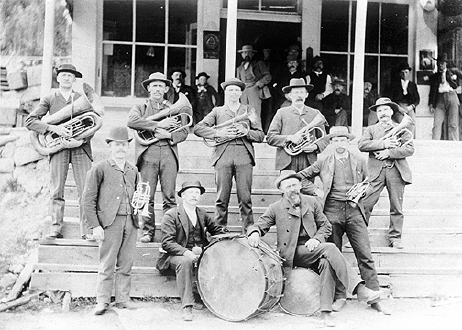
Photo: Colorado Historical Society
More About This Topic
Brass bands were popular during the late 1800s. They played concerts in city parks and marched in parades.
Their Own Words
"Of those palaces of entertainment, one was called the 'Red Light Dance Hall,' while the other was known as 'Fat Jack’s Place,' both being a combination of saloon and dance hall. One of these...observed the Sabbath by requiring the orchestra to play sacred music on Sunday evenings for patrons to dance by.... These were the sort of patrons who celebrated every evening, Sundays included, at which time they tripped the 'light fantastic toe' to the strains of such good old hymns as 'Jesus, Lover of My Soul' or 'The Beautiful Gates Ajar.'" "Other old-time sacred standbys, written to common or four-four time, also apparently served the crowd as satisfactorily while they went through the evolutions and convolutions of the old-time square dances. No stranger could set foot in one of these dance halls without being importuned to have at least one dance or to stand treat [buy a drink]--the “ladies” receiving a certain percentage on every dance or treat. As a rule they encouraged their partners to celebrate, while they partook of lighter refreshments that did not incapacitate them for dancing, as that would cut down on their earnings."
Source: George A. Root, “Gunnison in the Early ‘Eighties,” The Colorado Magazine, 9 (Nov. 1932): 203-204.
Fiddle Player
This miner is holding a violin or fiddle on his lap.
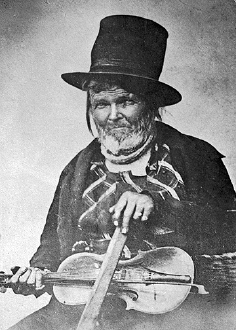
Photo: Colorado Historical Society
More About This Topic
Nearly every mining camp had someone who could play the fiddle. The fiddle player was much in demand to play for dances and to play tunes wherever people got together.
Their Own Words
“An occasional dance was always a drawing card for many of the boys, although we had no original dance hall until after the cheese factory went out of business. It was then fixed up for a community meeting place and the floor finished off for dancing. There was no orchestra and music was furnished by whatever was available—violin, guitar and piano most of the time. I remember an old violin player that used to play for the dances. He was a colored man and worked at the charcoal kilns at Dake, on the east side of Kenosha Pass. . . . I don’t ever remember hearing his last name. But he sure liked to play the fiddle and seemed to enjoy coming to Jefferson to play. He was always willing to come whenever the folks sent word to him.”
Source: George W. Champion, “Remembrances of South Park,” Colorado Magazine, 40 (January 1963): 23.
Silver Plume Marching Band
This is a photo of the Silver Plume marching band. The photo was taken at the Blue Ribbon Mineral Springs in the town of Idaho Springs.
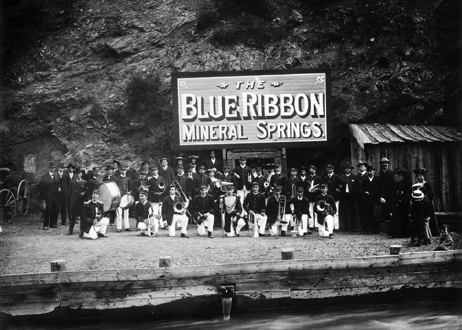
Photo: Denver Public Library, Western History Collection
More About This Topic
Popular brass bands traveled to play concerts in other towns. The band in this photo was from Silver Plume. It was playing at a mineral springs in the neighboring town of Idaho Springs. Mineral springs where people bathed in mineral water were popular gathering places. Brass bands also played at important public occasions.
Their Own Words
“The first train [to arrive in Central City] consisted of a dummy engine and a street car, which was welcomed to Central with a grand celebration. Fire companies, [brass] bands, fraternal societies, the Emmet Guards and hundreds of citizens were at the station in Central for this great event. . . .”
Source: C. H. Hanington, “Early Days of Central City,” Colorado Magazine, 19 (January 1942): 13.
Mrs. Peyer Plays The Piano
This is a photo of Paul Peyer and his wife at their home in Leadville. Mrs. Peyer is seated at a piano.
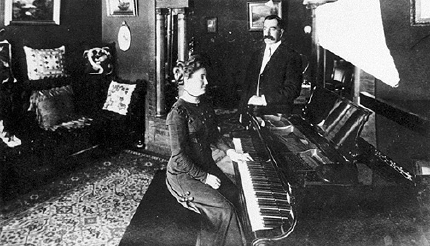
Photo: Colorado Historical Society
More About This Topic
Wealthy families in mining camps often had a piano. But less wealthy people often placed great value on music and owned instruments of various kinds. Gathering around the piano to play and sing was one way they entertained themselves at home.
Their Own Words
“But the lady . . . was a friend of ours, and I took music lessons from her. . . . She gave me music lessons--and that was one thing I had to do. Seems like everybody in those days gave their children music lessons or had a piano. My brother had to take lessons too. I had to practice, and that was probably my chore--that I had to do.”
Source: Jennie Spence Brown quoted in Julie Jones-Eddy, ed. Homesteading Women: An Oral History of Colorado, 1890-1950, (New York: Twayne, 1992): 90.

